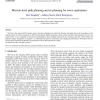Free Online Productivity Tools
i2Speak
i2Symbol
i2OCR
iTex2Img
iWeb2Print
iWeb2Shot
i2Type
iPdf2Split
iPdf2Merge
i2Bopomofo
i2Arabic
i2Style
i2Image
i2PDF
iLatex2Rtf
Sci2ools
RAS
2006
2006
Mission-level path planning and re-planning for rover exploration
The Life in the Atacama (LITA) project seeks to develop technologies for robotic life detection and apply them to the investigation of the Atacama Desert. Its field investigation in 2005 will demonstrate highly autonomous robotic science and daily multi-kilometer traverses over several weeks. A key component is mission-level path planning, which combines large-scale route selection, path and activity timing, and predictive energy management. Its purpose is to yield high-level plans for locomotion, solar charging and hibernation. We describe this new level of robotic autonomy and illustrate its performance from the field experiments in 2003. c 2005 Elsevier B.V. All rights reserved.
| Added | 14 Dec 2010 |
| Updated | 14 Dec 2010 |
| Type | Journal |
| Year | 2006 |
| Where | RAS |
| Authors | Paul Tompkins, Anthony Stentz, David Wettergreen |
Comments (0)

